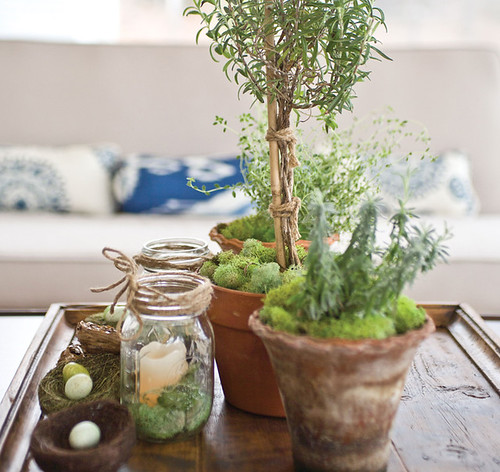A HINT OF GREEN

By Design Publishing

April 2016
a hint of green
Sure, it’s nice to see all that cheerful greenery and all those live, colorful flowers in your garden, in the park, or along the sidewalk. But wouldn’t it be nice to bring some of that natural beauty inside where you can enjoy it all year-round and in any kind of weather? Celia St. Onge of Cumberland, Maine-based Celia Bedilia Designs (celiabedilia.com), has figured out how to do just that.
Celia Bedilia, St. Onge’s nickname since childhood, started out as a home decor store in nearby Portland about ten years ago, but evolved into an interior design business that now produces a line of cottage furniture and creates natural arrangements for home interiors and events such as weddings. “I love using plants as centerpieces or simply as decor touches around a home. I feel natural elements look good anywhere, with any design style,” explains St. Onge. “I like classic, timeless plants, and I try to buy locally grown flowers and greens whenever possible.” St. Onge also uses many natural elements in her arrangements. “Wood slabs, birds’ nests, twine, burlap, branches, moss, tree bark—all work beautifully with live plants,” she adds. “And, I like clusters or groupings of containers for interest.” She uses twine, wire, and jute to finish a creation and often hangs an arrangement with these cords to add an unexpected element to a space or room.
St. Onge plants in Mason jars, old flea-market or junk-shop finds, or interesting terra-cotta pots and bowls. “I love Guy Wolff’s pots (guywolff.com) and I have several that I’ve collected over time,” she says. She prefers small seedlings rather than large plants because most of her arrangements are delicate in size.
Maine woodlands provide a variety of mosses, grasses, and natural elements for the designer’s arrangements, but she says most items can be purchased locally at greenhouses, garden centers, craft shops, or even grocery stores such as Trader Joe’s. “I like using long-lasting greenery accents, like hemlock or other evergreens and eucalyptus, all of which are easily available. Cuttings can be tucked into a planting and live without water for quite a long time,” says St. Onge. “Magnolia leaves and branches are also wonderful additions.”
Some of her favorite greens include easy-to-care-for succulents that can go without watering for as long as three weeks. She says herbs or lavender offer more than just an attractive display. “They have the benefit of a wonderful fragrance and can be used in cooking. Lavender can be pinched back to keep it small or trimmed into a topiary shape and it is very forgiving,” explains St. Onge. “If you forget to water it and the leaves droop, just give it a drink and it will usually come back.” Herbs and lavender need sun; ferns, another easy-care plant, should be planted near a north-facing window.





St. Onge likes to use candles in her arrangements. She puts green moss around the candles in large jars and sometimes wraps the container with large hosta or tulip leaves. Small candleholders are wrapped with burlap, ribbon, or twine and often placed among greenery arrangements for an attractive tablescape.
St. Onge adds that orchids are also incredibly easy to care for. “Simply do not put them in direct light and give them one ice cube each week. Once they have stopped blooming, they can be fed once every three weeks,” she advises. “Bulbs, on the other hand, like a sunny spot and need to be watered when they dry out. If they are planted in glass they do not need as much water as they do in terra-cotta. Terra-cotta absorbs the moisture.” St. Onge loves to grow bulbs in March, a very snowy, cold month in Maine. “I buy the bulbs in fall and keep them in the garage,” she says. “In February I plant them in containers and water them, but keep them in a cool place, like a basement. About ten days later, I bring them in the house and put them in a sunny place. They blossom in no time!” She sometimes uses curly willow to provide support for the flowers.
“I love nature and feel it’s fine to show a plant in dirt,” says St. Onge of her penchant for planting in clear-glass containers. Although she likes the idea of a terrarium, she doesn’t care for the way the water condenses on the glass. “It detracts from the arrangement,” she explains. “A cloche over the planting creates the same terrarium feel, but allows the moisture to escape, especially if it’s raised a tiny bit from the base.”
“My plant arrangements contribute to oxygen levels in a home. They are live, so [they] add dimension and warmth to a room,” says St. Onge. “I purposefully use plants that are easy to care for. I’m happy when the entire experience is a pleasant one for my client.” Written by Carolyn M. Runyon. Photography by Liz Donnelly, Maine Photo Co.
By Design Publishing
877-423-4567
208-772-8060
info@bydesignpublishing.com



As featured in Your Home and Lifestyle Magazine
Information deemed reliable but not guaranteed. All measurements are approximate. Copyright 2016 By Design Publishing. All rights reserved.


